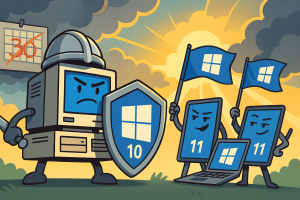 After nearly a decade, Microsoft is finally closing the book on Windows 10. As of today, free support and regular security patches have officially ended. But despite the headlines, your computer is not about to implode. If you plan wisely, or even just use decent security software, you can keep running Windows 10 safely for a quite a bit longer.
After nearly a decade, Microsoft is finally closing the book on Windows 10. As of today, free support and regular security patches have officially ended. But despite the headlines, your computer is not about to implode. If you plan wisely, or even just use decent security software, you can keep running Windows 10 safely for a quite a bit longer.
The End That Isn’t Really the End
Windows 10 still powers around 40 percent of all Windows devices worldwide. That’s hundreds of millions of PCs that won’t suddenly go dark. Microsoft’s formal support deadline simply means that future updates and bug fixes will stop unless you take additional steps.
To soften the landing, Microsoft is offering an Extended Security Updates (ESU) program that keeps critical patches flowing for another year, until October 13, 2026. Home users can enroll using a Microsoft account and Windows Backup or redeem Microsoft Rewards points. Businesses can pay for up to three years of ESU coverage that stretches support into 2028. The ESU plan delivers only vital security updates, no new features or design changes, but it does keep your system patched against the worst vulnerabilities.
Microsoft’s clear preference is that you upgrade to Windows 11 or buy new hardware that supports it. That said, many older PCs still run just fine, and some users have managed to install Windows 11 on unsupported systems with few issues beyond a little extra hassle during major updates.
What You Lose, What You Keep
- You lose free monthly security and bug‑fix updates, as well as direct technical support from Microsoft.
- You keep Microsoft Defender antivirus updates for now, plus continued support for Microsoft Edge, WebView2, and the Microsoft 365 apps through 2028.
That means your everyday apps will remain usable for quite a while. If you depend on Office 365, you’re still covered. And Edge will continue to receive maintenance updates for several more years.
What You Actually Risk, and What You Don’t
Let’s be honest: your Windows 10 PC will not turn into a brick tonight. If you take no actions, i.e., no ESU, no upgrade it will continue to boot, browse, and run apps exactly as it did yesterday.
With solid third‑party protections in place, the picture looks even better. Tools like Malwarebytes Premium, Bitdefender, or Emsisoft can still shield your system from most threats. Add a privacy‑conscious browser such as Brave or Firefox with uBlock Origin, and you’re in strong shape. Combine that with smart habits like no random downloads, not clicking on “You’ve won!” pop‑ups, and your actual day‑to‑day risk stays quite manageable.
The end of official support does not equal instant compromise. Still, Microsoft’s patches fix real exploits that bad actors eventually learn to target. Over time, unpatched flaws accumulate. That’s why this isn’t about panic; it’s about planning. You have breathing room. If you stay careful, you can ride out Windows 10 for a while longer, but remember: you’re on borrowed time.
Why Microsoft Offered ESU to Everyone
Until now, Extended Security Updates were reserved for enterprise customers. Offering them to home users acknowledges the obvious: too many PCs are still running Windows 10 to cut off all support. It also helps Microsoft avoid a global wave of unpatched systems that could become a cybersecurity problem. Regulators in Europe have also pressed the company to ensure smoother transitions for legacy devices, nudging this more flexible approach.
Five Smart Moves Right Now
- Check your version. Only Windows 10 22H2 qualifies for ESU.
- Decide whether to enroll in ESU. You can do it through your Microsoft account or via rewards points for a free year.
- Back up your data. Use an external drive or cloud storage so you can upgrade later without stress.
- Tighten security. Keep Malwarebytes or another trusted AV suite running, and lock down your browser extensions.
- Plan for the future. Whether it’s a clean Windows 11 install, a new PC, or even a move to Linux, start thinking ahead.
The Bigger Picture
Windows 10 was never supposed to end like this. When it launched in 2015, Microsoft called it “the last version of Windows,” promising perpetual updates instead of major releases. Then came Windows 11 and its stricter hardware rules, leaving millions of capable machines stranded. Ten years later, Windows 10 is proving stubbornly hard to kill because it still works, and because many users simply like it.
In practice, Windows 10’s life isn’t over. It’s entering its long farewell tour: patched if you choose, stable if you’re cautious, and perfectly functional if you keep your defenses up. ESU buys time, not immortality, but time is often enough.
Final Word
So yes, support for Windows 10 ends today. But the machines running it won’t vanish, and neither will the people who prefer its steady reliability. If you manage your security, keep backups, and stay alert, Windows 10 can still serve you well for a few more years.
The official chapter closes now, yet the story continues. Long live Windows 10.